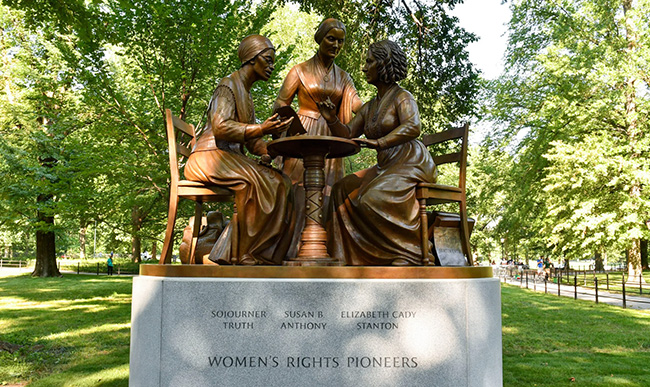When the non-profit group Monumental Women was created in 2014, there were no statues of real women from history in New York’s Central Park. The most-visited city park in the country had 22 statues of historical men, but the only women represented were Alice in Wonderland, Mother Goose, Juliet being kissed by Romeo, and various witches, nymphs, and angels.
But those statistics changed on August 26, 2020. After six years of organizing and $1.5 million in fundraising, Monumental Women unveiled the Women’s Rights Pioneers monument. It honors three 19th-century women who fought for women’s right to vote and the abolition of slavery – Sojourner Truth, Susan B. Anthony, and Elizabeth Cady Stanton. This bronze trio of life-size figures, created by Meredith Bergmann, became the first monument featuring real-life women in Central Park’s 167-year history.

The women in the statue seem to be having an animated discussion – a reminder that there were disagreements in the women’s suffrage movement in the late 19th century about the ratification of the 15th Amendment to the U.S. Constitution. The passage of the amendment gave African-American and other men of color the right to vote in 1870. Although Anthony and Stanton had both been strong advocates for the abolition of slavery, they had opposed the 15th amendment because it did not include voting rights for women.
Truth was a staunch supporter of women’s rights. She gave her most famous speech at a Women’s Rights convention in 1851 and stayed in Elizabeth Cady Stanton’s home for a week to attend the May 1867 Equal Rights Convention. But Truth had been a slave, and she sided with feminists who supported the 15th Amendment and voting rights for former slaves, even if it meant that women had to wait. The 19th Amendment granting women the right to vote was finally ratified 50 years later in 1920. None of the three women in the monument lived long enough to see that historic victory that they had worked so hard to achieve.
A New Monumental Project: “Lift Every Voice and Sing”
Last month, Monumental Women announced a new project. They are forming a coalition of groups and individuals to re-create Lift Every Voice and Sing, a masterpiece by the African-American sculptor, Augusta Savage, that was created for the 1939 World’s Fair in Queens, New York.
The 16-foot tall sculpture was intended to celebrate African Americans’ contributions to the world of music. It depicted a kneeling Black man holding a bar of music and 12 Black chorus singers representing strings on a harp, cradled in the hand of God as the harp’s soundboard.
Since Savage could not afford bronze or other durable materials, the piece was made of plaster that was lacquered to look like black basalt.
The piece was inspired by the popular African-American anthem, Lift Every Voice and Sing, which was written in 1900 by Savage’s friends, NAACP leader James Weldon Johnson and his brother, John Rosamond Johnson.
It was a common practice at the time to destroy artworks and other structures when a World’s Fair ended unless someone claimed them. Since Savage did not have the funds to move her piece to a storage location, Lift Every Voice and Sing was bulldozed in 1940, even though her piece had been one of the most popular artworks at the fair.
To honor Augusta Savage’s legacy, Monumental Women welcomes groups and individuals to join the coalition to re-create Lift Every Voice and Sing. If you would like to help, please join their team.
More About Augusta Savage
“I was a leap year baby, and it seems to me that I have been leaping ever since.” – Augusta Savage, born February 29, 1892
Augusta Savage (1892-1962) was a Harlem Renaissance sculptor and arts educator who followed her dreams in spite of her father’s disapproval and the racial discrimination of arts schools and museums.
She was the first person in the U.S. to open a gallery dedicated to African-American art. She also established the Savage Studio of Arts and Crafts in Harlem, where she trained a generation of African-American artists who later became nationally known.
Savage was a powerful arts activist who fought for the inclusion of Black artists in the mainstream canon. She was working as the director of the WPA-funded Harlem Community Arts Center in 1937, when she received the commission to create a piece for the 1939 World’s Fair. She was the only Black person and one of only four women to receive that honor.
In spite of her talent, most of Savage’s work has been lost or destroyed – a sad testament to the impact of poverty and racism on women artists of color that continues to this day.
To learn more about Augusta Savage, check out the excellent 22-minute documentary about Augusta Savage, which PBS released as part of their “American Masters” series in February 2024. Art historian Jeffreen M. Hayes, Ph.D. explores Savage’s legacy, and why her artwork has been largely erased.


